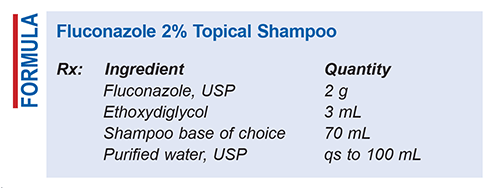US Pharm. 2024;49(4):59-60.

Method of Preparation: Calculate the required amount of each ingredient for the total volume to be prepared. Accurately weigh or measure each ingredient. Using a mortar and pestle, triturate the fluconazole into a fine powder; then mix the powder with the ethoxydiglycol until a homogenous mixture is formed. Gradually incorporate this dispersion into the shampoo base, and mix thoroughly until uniformly blended. Add sufficient purified water to reach a final volume of 100 mL. Once the mixture is uniform and well integrated, transfer it to an appropriate dispensing bottle.
Use: Fluconazole topical shampoo may be used to treat fungal conditions of the scalp, such as tinea capitis and seborrheic dermatitis.
Packaging: Package in a tight, light-resistant amber glass container.
Labeling: Protect from light. Shake well before use. Keep at room temperature. Discard after ____ [time period].
Stability: The USP default beyond-use date for aqueous topical products is 30 days.1
Quality Control: Weight/volume, pH, specific gravity, active drug assay, color, rheologic properties/pourability, physical observation, and physical stability (discoloration, foreign materials, gas formation, mold growth) are all examples of quality-control assessments.2
Discussion: Fluconazole, a synthetic triazole antifungal agent, acts against fungal infections by inhibiting sterol synthesis in fungal cells and interfering with the formation of cell walls. Fluconazole’s mechanism of action involves inhibition of ergosterol synthesis, a crucial component of fungal cell membranes. This leads to membrane destabilization, cellular-content leakage, and ultimately the death of fungal cells. These properties make fluconazole effective for reducing the fungal load on the scalp, thereby alleviating signs and symptoms such as flaking, scaling, and itching.3,4
Fluconazole 2% topical shampoo serves the dual purpose of cleansing the hair and scalp while directly treating the fungal infection. It should be used frequently during shower routines. The shampoo should be applied to damp hair and scalp, and a thick lather should be created before rinsing well. The frequency and duration of use should be determined based on the specific condition being treated.3-5
Fluconazole (Diflucan, C13H12F2N6O, MW 306.27) is available in tablet and powder form for oral administration. It is a white, crystalline solid that is slightly soluble in water and in saline. Fluconazole undergoes minimal hepatic metabolism and inhibits enzymes such as CYP2C9, CYP3A4, and CYP2C19. Caution should be exercised in patients with potential proarrhythmic conditions because of possible QT prolongation.3,6
Ethoxydiglycol (CH2OHCH2OCH2CH2OC2H5, C6H14O3, MW 134.20) is also known as diethylene glycol monoethyl ether, diethylene glycol ethyl ether, Transcutol, and Carbitol. Ethoxydiglycol occurs as a colorless liquid with a mild odor, and it has a density of 1.0272. A hygroscopic organic solvent, it can be mixed with water and other organic solvents. Ethoxydiglycol improves the solubility and permeability of active ingredients and functions as a solubilizer and cosurfactant. Ethoxydiglycol is nonirritating and nonpenetrating when applied to the skin.7
Shampoos are complex formulations containing primary anionic surfactants such as alkyl sulfates, secondary surfactants for lather enhancement, and various additives for stability and conditioning. One shampoo base that is suitable for this formulation is VersaPro Shampoo, which is sulfate-free and enriched with panthenol to repair and strengthen damaged hair.4,8,9
Purified water, which is obtained through processes such as distillation or reverse osmosis, is stable and miscible with most solvents.10
REFERENCES
1. U.S. Pharmacopeia/National Formulary [current revision]. Rockville, MD: U.S. Pharmacopeial Convention, Inc; September 2022.
2. Allen LV Jr. Standard operating procedure for performing physical quality assessment of oral and topical liquids. IJPC. 1999;3:146-147.
3. Fluconazole. In: Trissel LA. Trissel’s Stability of Compounded Formulations. 5th ed. Washington, DC: American Pharmacists Association; 2012:207.
4. Cosmetics for special populations and for use as vehicles. In: Allen LV, Jr. The Art, Science, and Technology of Pharmaceutical Compounding. 4th ed. Washington, DC: American Pharmacists Association; 2012:441.
5. Ghannoum MA, Rice LB. Antifungal agents: mode of action, mechanisms of resistance, and correlation of these mechanisms with bacterial resistance. Clin Microbiol Rev. 1999;12(4):501-517.
6. Diflucan (fluconazole) product information. New York, NY: Pfizer Inc; February 2019.
7. Ash M, Ash I. Handbook of Pharmaceutical Additives. Brookfield, VT: Gower Publishing Ltd; 1995:484.
8. Trüeb RM. Shampoos: ingredients, efficacy and adverse effects. J Dtsch Dermatol Ges. 2007;5(5):356-365.
9. VersaPro™ Shampoo. www.medisca.com/products/versapro-shampoo. Accessed March 1, 2024.
10. Dubash D, Shah U. Water. In: Sheskey PJ, Cook WG, Cable CG, eds. Handbook of Pharmaceutical Excipients. 8th ed. London, England: Pharmaceutical Press; 2017:1012-1016.
The content contained in this article is for informational purposes only. The content is not intended to be a substitute for professional advice. Reliance on any information provided in this article is solely at your own risk.
To comment on this article, contact rdavidson@uspharmacist.com.





